Discover Kiteboarding Lessons in Corpus Christi
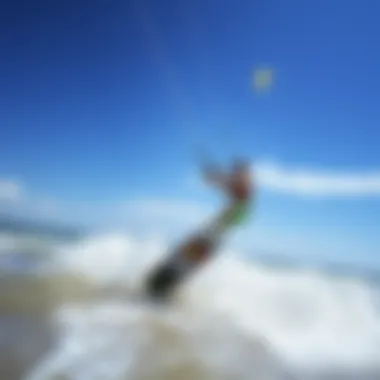
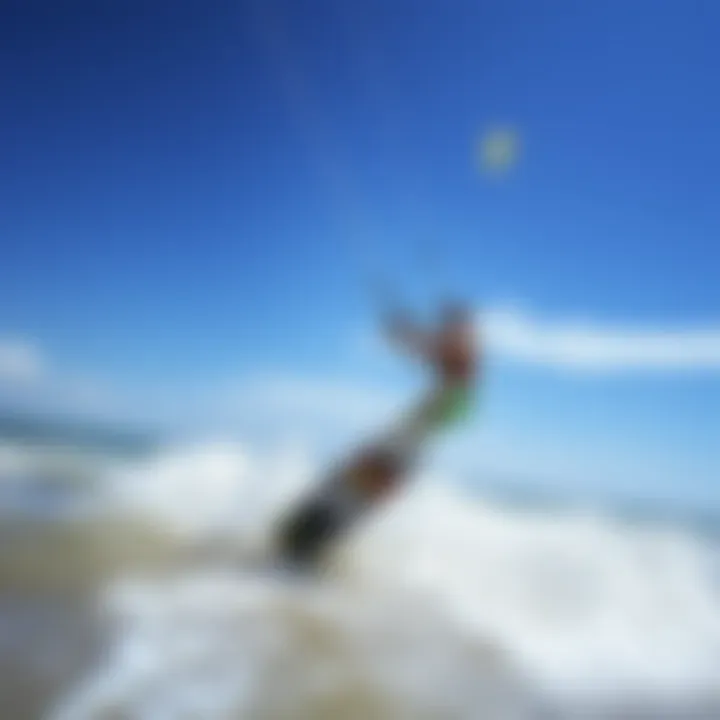
Intro
Kiteboarding in Corpus Christi offers a unique experience that draws enthusiasts from around the globe, whether they’re just starting out or looking to refine their skills. The locally favorable wind conditions and expansive shorelines create a backdrop that is not only visually stunning but also practical for kiteboarding activities. Here, learners can find the perfect environment to navigate the basics of kite control, while advanced kiteboarders can dive into more complex maneuvers.
In this guide, we will explore the essentials of kiteboarding lessons in this vibrant coastal city. We’ll cover everything from the equipment used, instructor qualifications, lesson formats, and safety measures to broader cultural insights into the kiteboarding community here. By the end, you should have a clear understanding of what to expect when you hit the water for your first lesson or when you decide to upgrade your skills with more advanced training.
Foreword to Kiteboarding in Corpus Christi
Kiteboarding represents a thrilling confluence of wind and water, making it one of the most popular water sports today. In Corpus Christi, the kiteboarding scene is vibrant and diverse, drawing in both beginners eager to learn and seasoned riders itching to refine their skills. The importance of exploring this sport in the region can't be overstated, as it acts not just as a recreational activity, but also fosters community, promotes an active lifestyle, and invites environmental awareness.
Overview of Local Kiteboarding Scene
Corpus Christi is a hub for kiteboarding, thanks to its unique geography and favorable wind conditions. Imagine an expansive skyline meeting the glistening waters of the Gulf of Mexico—that’s the view that greets kiteboarders hitting the waves. Local riders share their tales, ranging from thrilling surf escapades to serene moments watching sunsets while gliding on the water. The community thrives on camaraderie, with experienced kiteboarders often stepping up to mentor newcomers, thus fostering a welcoming atmosphere.
In addition to local enthusiasts, Corpus Christi hosts various events, such as competitions and festivals, that not only showcase the talent of riders but also introduce the sport to curious onlookers. The exchange between locals and visitors creates a lively scene where enthusiasts from all walks of life can come together. From the bustling beaches packed with thrill-seekers to quieter spots offering stunning views, the local kiteboarding scene is as diverse as the people who inhabit it.
Why Corpus Christi is a Prime Location
When pondering over why Corpus Christi stands out as a prime destination for kiteboarding, several compelling factors come into play:
- Consistent Wind Conditions: The region is blessed with steady winds, providing kiteboarders with ample opportunities to ride throughout most of the year. Ideal wind seasons mean fewer frustrations for learners and more enjoyment for veterans.
- Diverse Water Conditions: From flat water to choppy waves, the variety caters to all skill levels. Beginners can find serene spots to learn, while advanced kiteboarders can seek out more challenging conditions that offer adrenaline-packed experiences.
- Beautiful Scenery: Beyond the sport, the natural beauty around Corpus Christi enhances the experience. Gliding over crystal-clear waters while basking in warm sunlight is a draw that few places can match.
- Strong Community: The kiteboarding community is supportive and engaging. Instructors are typically passionate about teaching and providing a safe learning environment. The close-knit nature of the community often leads to lasting friendships built on a shared love for the sport.
"Kiteboarding is more than just a sport; it’s a lifestyle. In Corpus Christi, every ride is a chance to connect with nature and with others who share your passion."
Understanding Kiteboarding Lessons
Kiteboarding relies heavily on mastering the skills and understanding the gear involved, which makes it crucial to delve into kiteboarding lessons. These lessons are often the bridge between a beginner’s curiosity and their future zest for the sport. Grasping the importance of well-structured lessons can shorten the learning curve and ensure safety, which is paramount.
Structure of Lessons
The backbone of a great learning experience in kiteboarding is its structured lesson plans. The way lessons are laid out can greatly influence how quickly a student progresses.
Beginner Classes
Beginner classes serve as the foundation for aspiring kiteboarders. They give an introductory look at the equipment, safety protocols, and basic techniques. These classes often consist of on-land training, which lets students become familiar with the kite without being in the water. A notable feature of beginner classes is the focus on safety; students learn essential techniques to ensure they can kiteboard without endangering themselves or others. The positive aspect of these classes is that they instill confidence early on and cover the bases of kite handling, wind awareness, and board skills. However, one must be prepared for the slow pace as this is vital for thorough understanding.
Intermediate Training
As students progress, intermediate training elevates their skills, building on the basics learned during beginner classes. These sessions often focus on refining techniques, turning skills and learning to navigate in various wind conditions. A key characteristic of intermediate training is its emphasis on personalization; instructors often tailor lessons based on a pupil's unique needs and skill gaps. The advantage of this tailored approach is that students can quickly see improvement addressing their specific challenges. However, some riders may feel slightly overwhelmed if they advance too quickly, which can be demotivating. It's crucial to maintain a balance between pushing limits and providing adequate support.
Advanced Techniques
Advanced techniques are where the sport's true thrill lies, allowing experienced kiteboarders to explore new tricks and refine their style. These lessons are typically intended for those who already have a solid foundation and are looking to transcend standard skills. A major feature of advanced techniques is that they introduce more complex maneuvers, teaching riders how to harness the power of the kite in dynamic scenarios. Riders can learn how to jump, do tricks, and manage higher wind speeds. The benefits of such lessons are undeniable; they can significantly boost a rider's confidence and skill level, ferreting out a unique style. Yet, this phase requires discipline and patience, as mastering new tricks can often involve several failed attempts.
Instructor Qualifications
Now, let's talk about what makes a great instructor. The value of well-qualified instructors cannot be overstated. Their expertise shapes the quality of lessons and ultimately impacts a student’s relationship with kiteboarding.
Certifications and Experience
Certified instructors bring a wealth of knowledge borne from experience. They are not just enthusiasts but trained professionals who understand the nuances of kiteboarding. A crucial aspect of certifications is that they signify a formal endorsement of safety practices and teaching methodologies. When students are aware their instructors are certified, it often breeds trust, which enhances their learning experience. However, the depth of experience also matters – instructors with years of riding and teaching can offer insights that might not be covered in standard certifications, making them an invaluable resource. The disadvantage, though, lies in the fact that not every great rider is also a great teacher; thus, finding someone with both expertise and effective teaching skills is essential.
Teaching Approaches
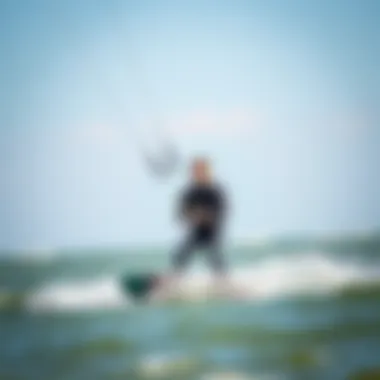
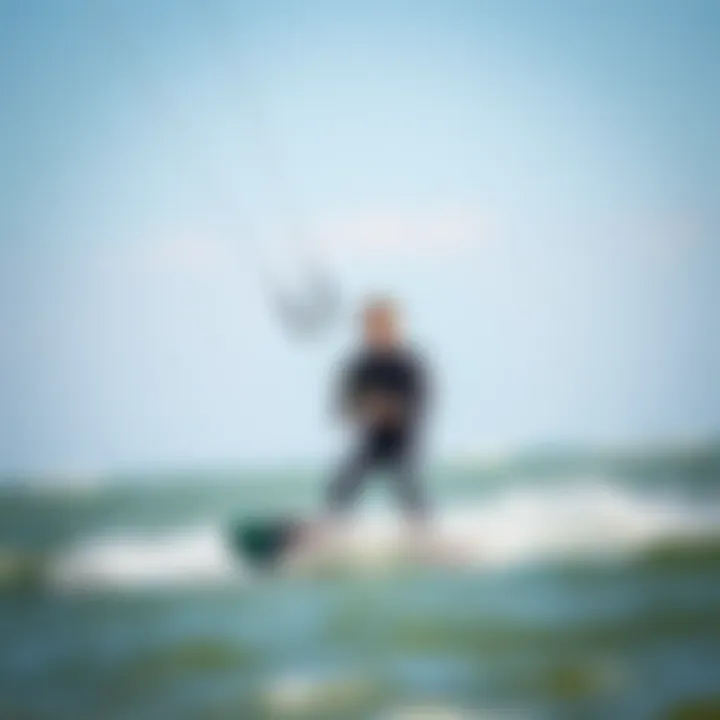
Different teaching approaches can greatly shape how effectively students learn. Some instructors may use a more hands-on, direct method, while others encourage patience and self-discovery. A beneficial aspect of employing varied approaches is that they can cater to diverse learning styles within the same class. For instance, visual learners may benefit from watching demonstrations, while kinesthetic learners require practice to grasp the concepts. This adaptability is key in maximizing student potential. On the flip side, students might become confused or frustrated if instructors jump between methods too frequently, highlighting the need for consistency in teaching.
Understanding these fundamental aspects of kiteboarding lessons helps novice kiteboarders establish a strong base while also ensuring that intermediate and advanced riders continually enhance their skills. This layered approach ensures that all learners, regardless of experience, can progress in a safe and supportive environment.
Equipment Essentials for Successful Lessons
The right equipment can be the difference between a thrilling kiteboarding experience and a disastrous one. In Corpus Christi, where winds can pick up quite suddenly, having the essential gear not only enhances performance but also ensures safety on the water. Understanding what to use, including kites, boards, and safety accessories, equips learners and enthusiasts alike, allowing them to focus on mastering their kiteboarding skills without unnecessary distractions.
Types of Kites and Boards
Choosing the Right Equipment
Choosing the right equipment is crucial for a satisfying kiteboarding experience. Each kiteboarder has their own unique requirements based on skill level, body weight, and personal preferences. A kite's size can significantly affect your control and ability to fly smoothly. For example, those new to the sport generally benefit from larger kites which are easier to manage in lower winds, while experienced riders might prefer smaller, more responsive kites that allow for acrobatics and better performance in high winds.
When selecting a board, look for a balance between stability and agility. A wider board offers more stability but might be harder for advanced maneuvers. Thus, the right choice should feel intuitive; riding it should be second nature, enhancing rather than hindering your progress.
Brands and Models
In the world of kiteboarding, several brands stand out—each offers distinctive features that cater to different styles. Naish and Cabrinha are well-known for their durable kites and versatile boards, often favored by professionals. Simultaneously, companies like Slingshot focus on innovation, introducing models that prioritize speed and maneuverability.
Each brand comes with unique designs tailored to specific riding styles. For instance, if you're ambitious about mastering tricks and jumps, a lightweight model may suit you better. Keep in mind, however, that the latest models can be pricey; therefore, balancing quality and cost is essential to maximize value without breaking the bank.
Safety Gear and Accessories
Wetsuits and Harnesses
For many kiteboarders, dressing appropriately for the elements is a must. Wetsuits not only keep you warm but also provide a certain degree of buoyancy. A well-fitted wetsuit can enhance your comfort, allowing you to focus on riding instead of shivering from the cold.
Harnesses are another critical piece of equipment. They relieve pressure from your arms by attaching the kite line to your body, letting you control the kite more easily. A good harness sits snugly and doesn't restrict your movement, which is vital when executing those tricky moves.
Safety Leashes and Helmets
Wearing a helmet is often overlooked, yet it can be a lifesaver. A helmet protects you from unexpected impacts, especially for those venturing into waves or crowded areas. Coupled with a safety leash, which prevents the kite from drifting away uncontrollably if you fall, it forms a crucial safety net.
Using a safety leash helps ensure you're always connected to your gear, minimizing the risk of injury. Most brands offer leashes equipped with quick-release mechanisms, giving you a way out in an emergency situation. Every kiteboarder should prioritize these pieces of gear to cultivate a safe and enjoyable learning environment.
Safety and Risk Management
In the exhilarating world of kiteboarding, safety cannot be overstated. It's the bedrock that underpins successful lessons and enjoyable experiences on the water. As kiteboarding continues to gain popularity in Corpus Christi, understanding and managing risk becomes crucial for both instructors and students. By prioritizing safety, you not only protect yourself but also elevate the quality of your lessons, fostering a culture of responsibility and fun.
Understanding Kiteboarding Risks
Environmental Hazards
Kiteboarding in Corpus Christi presents its own unique set of environmental challenges that can greatly affect the experience of learning and riding. One notable environmental hazard is the unpredictable behavior of wind patterns. The winds can shift unexpectedly, causing challenges for even experienced riders. Furthermore, shallow areas in certain local spots can pose risks of collision with underwater obstacles.
The key characteristic of these environmental hazards is their variability. They differ significantly depending on the time of year, the location, and even the time of day. This variability makes it an exciting but sometimes treacherous environment for beginners who may not yet be equipped to handle unexpected changes.
In essence, understanding these environmental factors gives novice kiteboarders an edge, enabling them to read conditions better and make informed decisions. For instance, being aware of tidal patterns can help determine the best times to kiteboard, mitigating risks and leading to a safer, more enjoyable experience. However, new learners must also understand the limitations of their abilities and wait for the right conditions before attempting to hit the waves.
Technical Safety Measures
When it comes to technical safety measures, these involve the gear and practices that enhance safety during lessons. For instance, using reliable safety leashes is paramount. These leashes serve as a lifeline, allowing the kiteboarder to control the kite in case of an emergency, reducing the chance of accidents.
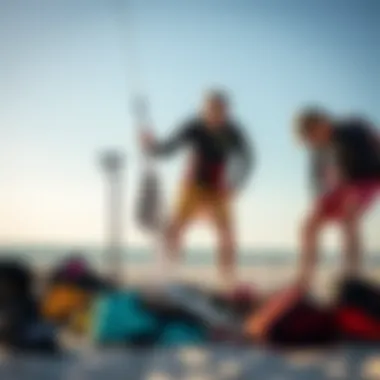

Moreover, the use of equipment like helmets and impact vests adds a layer of protection against potential falls. The critical element here is the material and design of this safety gear, which should meet industry standards. Choosing well-reviewed brands can also make a difference in safety outcomes.
The adoption of proper technical safety measures is an essential element of any kiteboarding lesson. Thus, both instructors and students should regularly review their equipment, confirming its safety and reliability. This diligence not only protects individuals but also cultivates a greater sense of overall security within the kiteboarding community.
Safety Protocols During Lessons
Integrating safety protocols during lessons is not just advisable but necessary. These protocols include a thorough briefing before each session, where students learn about the gear they'll be using, what to expect during the lesson, and emergency procedures.
Additionally, instructors should emphasize the importance of buddy systems, encouraging students to keep an eye out for each other. This collaborative approach fosters a supportive learning environment while enhancing overall safety on the water. By standardizing safety protocols, kiteboarding lessons can focus more on skill development and less on mitigating risks.
Post-Lesson Analysis and Progress Tracking
Analyzing performance post-lesson is just as important, if not more, as the actual kiteboarding lesson itself. Many kiteboarding enthusiasts might feel a moment of exhilaration after a thrilling ride on the water, but it is crucial to step back and assess what went right and what could use some tweaking. This analysis lays the groundwork for continual improvement and enhances the overall learning experience.
Effective post-lesson analysis serves several purposes. First off, it offers a chance for riders to reflect on their skills and how they executed various techniques during the lesson. Understanding your strengths and areas for improvement can be like shining a light in dark corners—you see where you’ve excelled and where you’ve stumbled. Secondly, this reflection fosters a deeper connection with the sport itself. Riders who know where they've faltered often find themselves more engaged in the learning process, eager to conquer the next challenge.
> "The greatest teacher, failure is."
-Dalai Lama
Evaluating Performance
Performance evaluation is a structured process that assesses how well the skills and techniques taught during the lesson were applied. It usually includes feedback from instructors who provide insights on how the rider performed. A few key factors come into play during this evaluation:
- Technical Skills: Did the student manage to execute the basic maneuvers correctly? Were there any noticeable physical adjustments needed to improve their stance or body positioning?
- Environmental Awareness: How did the rider handle the wind and water conditions? Did they demonstrate good judgment in adapting their techniques to what nature was throwing their way?
- Independence: Did the kiter show signs of independent decision-making? Could he or she troubleshoot minor issues that popped up while riding?
This feedback loop is integral to the learning process. Capturing this information can be useful for gauging future progress or addressing any hurdles that might arise down the line. After all, having a clear picture of where you stand allows for a tailored approach to subsequent lessons, whether that means diving into new techniques or revisiting the fundamentals.
Setting Future Goals
Once performance has been assessed, it's time to channel that critical information into setting actionable future goals. This can be a game-changer—not only does it give riders a path to follow, but it also keeps motivation running high. Here's how to steer that focus:
- Short-term goals: These can be achievable objectives like mastering a particular trick or improving on speed during transitions.
- Long-term goals: Here, riders can aim for bigger milestones—perhaps preparing for a competition or going for an advanced certification in kiteboarding.
- Skill development focus: Target areas identified during the performance evaluation. If a student struggled with jumps, for example, adding this to the goals will keep their eyes on the prize.
Creating a blend of immediate and long-range goals can spark a sense of purpose. It transforms the sport from mere enjoyment to a fulfilling journey of personal development.
In summary, the post-lesson analysis and the subsequent goal-setting are not just about improving skills—they are about building a sustainable relationship with kiteboarding that fosters passion and commitment.
Community and Culture of Kiteboarding in Corpus Christi
The vibrancy of the kiteboarding scene in Corpus Christi extends beyond just the thrill of the sport; it is deeply rooted in a community that fosters camaraderie, skill sharing, and a profound love for the ocean. The essence of kiteboarding here is not merely about catching the wind on a board; it’s about connecting with others who share a similar passion. This community aspect can significantly enhance the kiteboarding experience, creating deeper friendships and memories that last well beyond a day on the water.
Local Events and Competitions
Events and competitions play a pivotal role in building the kiteboarding culture within Corpus Christi. They not only serve as a platform for riders to showcase their skills but also help to unite enthusiasts in a common cause. Events like the annual Corpus Christi Bay Kite Fest provide an opportunity for both amateurs and pros to compete, learn from each other, and celebrate their shared love for the wind and waves.
"These events are where the magic happens – everyone’s in it together, cheering each other on. It’s a beautiful thing to witness."
Join in these competitions, and you’re likely to find a welcoming atmosphere. Local shops often sponsor participants or provide gear; this support bolsters not just the competitors but the entire community. Plus, workshops typically accompany these gatherings, focusing on various aspects of kiteboarding, from technique to safety, ensuring all riders leave with new knowledge to advance their skills.
Building Connections with Other Riders
Kiteboarding is inherently a social sport, which allows for spontaneous interactions and connections among riders. As individuals gather at launch sites like North Packery Channel, friendships are often forged over shared tips, tales of wipeouts, and exhilarating rides.
One of the best parts about this hobby is the accessibility to create connections. Whether you are a newbie or an experienced rider, there's always someone willing to help. The fluid dynamics of water sports encourage riders to support each other, sharing gear reviews, instructional tips, or even just a friendly chat about the best spots to kiteboard at different times of the year.


The local kiteboarding community often utilizes Facebook Groups and forums on places like Reddit to keep the conversation flowing. These platforms allow for the exchange of information and experiences, making it easier for newcomers to feel integrated into the scene.
Connecting with fellow kiteboarders not only enriches the sport but also cultivates a collective responsibility for preserving the environment and promoting sustainable practices. The shared passion for kiteboarding creates a network of support and diversity, cultivating not just better riders, but also community activists.
Resources for Kiteboarding Enthusiasts
When diving into the world of kiteboarding, having access to the right resources can make a considerable difference in one’s learning curve and overall enjoyment of the sport. Corpus Christi, with its vibrant kiteboarding community, offers a wealth of opportunities for newcomers and seasoned riders alike. Knowing where to find valuable information, skilled instructors, and supportive peers can enhance not just technical skills but also enrich personal experiences on the water.
Recommended Schools and Instructors
Selecting a quality kiteboarding school or instructor is key for any aspiring kiteboarder. In Corpus Christi, several schools stand out for their commitment to safety and effective teaching methods. Here are a few notable choices:
- Kiteboarding Corpus Christi: Known for their structured lesson plans that cater to all skill levels, this school employs experienced instructors who prioritize safety on the water.
- Sail & Surf: This establishment offers a wide array of courses, from introductory lessons for beginners to advanced technique workshops for those wanting to refine their skills. The instructors are patient and skilled at adapting their teaching style to meet individual needs.
- Texas Kiteboarding: Situated right at the coast, this school prides itself on providing not just lessons but also a community for kiteboarders. Their mentoring system allows newer riders to connect with more seasoned enthusiasts.
These schools typically offer packages that include equipment rental, which can be an economical way to get started without a hefty upfront investment. When choosing a school, it’s beneficial to look for reviews or testimonials from past students to gauge the quality of instruction. Remember, a good instructor will not only teach skills but also instill confidence in their students.
Online Learning Platforms and Tools
In addition to in-person lessons, online resources are becoming increasingly popular in the kiteboarding community. They can complement what you learn on the water and provide valuable information that can streamline your progression. Here are notable online platforms to consider:
- Kite Class: This online platform specializes in videos and tutorials specifically detailed for kiteboarding. It has various lessons, ranging from setup, safety measures, to advanced tricks.
- YouTube: A treasure trove of content, with numerous channels dedicated to kiteboarding. Some notable channels to explore include "Kiteboarding.com" and "Epic Kiteboarding" for tips and product reviews.
- Kiteforum.com: An interactive community site where riders can exchange tips, share experiences, and seek advice. It’s a great space to ask questions and learn from those who’ve been through various stages in their kiteboarding journeys.
These tools can be especially helpful in understanding the finer details of kiteboarding equipment, weather conditions, and safety practices, which can significantly elevate one’s kiteboarding skills. Remember, combining these resources with hands-on experience is the formula for success in the sport.
"Regardless of where you are in your kiteboarding journey, make the most of available resources. They’re out there, waiting for you to grab them!"
Incorporating both local and online resources equips kiteboarders of all levels with the tools necessary for a safe and enjoyable experience on the water. Corpus Christi isn’t just a beautiful backdrop; it’s also a gateway to a thriving kiteboarding network.
Environmental Considerations and Sustainability
As kiteboarding gains popularity, the attention to its environmental footprint becomes crucial. Understanding the interaction between this exhilarating sport and the local ecosystems of Corpus Christi helps to ensure that the delicate balance of nature is maintained. The push for sustainability in kiteboarding practices not only preserves the beauty of the waters but also contributes to a healthier marine life, ultimately enhancing the overall kiteboarding experience.
Impact of Kiteboarding on Local Ecosystems
Kiteboarding can leave a mark on the environment if not approached with care. The wind and water exert influence in tandem, creating the perfect playground for enthusiasts. Yet, this joy comes with responsibilities. The presence of kites in the air, dragging boards through the water, can disturb aquatic habitats. For instance, when kiteboarders launch their kites or crash them into the water, there's the potential for disruption to breeding grounds for fish and other marine life. Additionally, careless behavior, like riding too close to shore, can damage fragile vegetation like sea grasses, which play a vital role in preventing erosion and providing habitat.
"A little knowledge can go a long way; understanding the ecosystem can help preserve the very spots we cherish for kiteboarding."
To combat these negative impacts, it becomes essential for kiteboarders to respect the regions they frequent. Simple habits, such as maintaining distance from nesting areas and using designated launch sites, allow for a more harmonious coexistence with nature.
Promoting Responsible Kiteboarding Practices
Educating riders about responsible kiteboarding practices is key to ensuring sustainable enjoyment of the sport. Here are some steps that can be taken:
- Participate in Local Clean-Up Events: Engaging in community efforts helps maintain the beauty of natural environments, allowing for shared responsibility among riders and local communities.
- Follow Environmental Regulations: Many areas have specific guidelines designed to protect local wildlife and habitats. Familiarizing oneself with these regulations can provide a solid foundation for responsible riding.
- Choose Eco-friendly Gear: Opting for equipment made from sustainable materials can reduce the environmental impact. Many brands are now undertaking initiatives that focus on creating sustainable kiteboarding gear.
- Spread Awareness: Encourage fellow riders not only to enjoy the sport but also to respect the environment. This can foster a community of kiteboarders who are not just skilled in the sport but also champions of environmental conservation.
By taking actionable steps towards sustainability, kiteboarders can enjoy the thrilling winds of Corpus Christi while ensuring that future generations can experience the unaltered beauty of the landscapes they love. It’s about keeping the balance, maintaining respect for nature at all times, and having a blast while doing so.
The End
The importance of understanding the lessons' structure cannot be understated; it forms the bedrock on which skills are built, from the first timid launches to complex maneuvers that prove mastery over the board and kite. Moreover, knowing the qualifications and certifications of instructors ensures that safety and effective teaching methodologies are prioritized throughout the learning journey.
In the context of equipment, the right kite and board can drastically affect one’s learning curve. Familiarity with different types and knowing which gear suits one’s level and conditions can make the difference between flying high and a frustrating session.
"Success in kiteboarding isn’t just about the wind and water, but about learning how to blend the two with grace and understanding."
Furthermore, awareness of the environmental impact of this sport highlights a crucial element that every rider must consider. When kiteboarders embrace responsible practices, it nurtures the ecosystem while ensuring future generations can enjoy the same thrills.
The social fabric of Corpus Christi further enriches the kiteboarding experience, fostering connections among riders and encouraging participation in local events. Strengthening this community not only spurs personal growth but also creates lasting friendships and memories.







